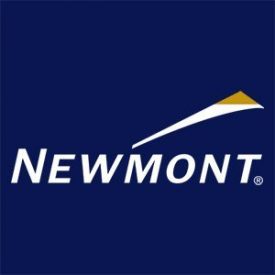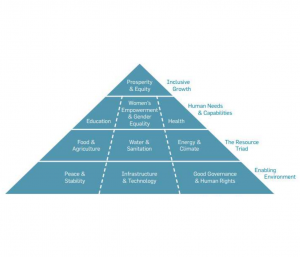Overview
Newmont’s global water strategy was developed to address their operational uses while supporting the needs of neighboring communities for safe and plentiful water. Newmont recognized the right to water as a salient human rights risks for its company.
This global strategy translates to the operational level, where by 2014, each site has developed a water management charter and plan using an integrated, basin-wide approach that addresses stakeholder and mine water needs and meets all applicable laws and regulations. The charters map out a strategic plan to improve water management at all sites of Newmont over the next three to five years.
Examples from Newmont sites include:
Newmont Ghana has installed new wells, monitored ground-water supplies, improved sanitation and worked closely with local communities on monitoring and protecting water quality. A focus point of Newmont Ghana’s work is to address the impacts caused by its operations, particularly focusing on the influx of populations and booming communities that result. Some activities include: funding the construction of the Kenyasi water project at a cost of GH¢435,902. The project with a storage capacity of 390 cubic metres is an extension of the Kenyasi Small Town Water Project, which hitherto had a storage capacity of 18 cubic metres; it is expected to pump about 30, 000 litres of water per hour to serve the growing population of Kenyasi No.1 & 2, as well as surrounding communities. The Newmont Golden Ridge Akyem Project focuses on expanding and rehabilitating water and sanitation for communities affected by its operations. The expansion included the provision of 13 boreholes drilled in all the project impacted communities.
In Peru, the Minera Yanacocha recently invested in a number of projects aimed at optimizing water management and supply in the nearby village of Yerba Buena Chica. As a result of these improvements, 157 families now have more reliable access to potable water, as well as indoor toilets. By upgrading the capacity and technology of Yerba Buena Chica’s water infrastructure, the community also is benefiting from improved sanitation, which helps reduce the spread of disease.
The Yerba Buena Chica project is just one of the many ways Yanacocha is demonstrating its commitment to community development through improved water management. In 2013, Yanacocha partnered with Cajamarca’s municipal water authority to improve water availability to nearly 180,000 people. This joint initiative by the municipal water authority and Yanacocha is focused on expanding and optimizing water pipelines; upgrading the capacity and technology of local water treatment plants; and constructing a new reservoir and network system in the suburb of Mollepampa. It is an important, long-term investment that will support future growth and development in the area, which is being driven in large part by mining. Since work began, the number of projects has risen from seven to 10, with total funding from Yanacocha increasing to more than $13 million.
Country(ies) where the intervention is taking place
Ghana, Peru, Kenya, others.
Lead Organization
Newmont.
Who is involved?
Cajamarca’s municipal water authority.
Objectives
Improve the neighboring communities’ access of the safe and plentiful water, and improved sanitation.
Workplace Setting
Communities around operations.
Which elements of WASH are covered?
Water, sanitation and hygiene.
Which elements of the Framework for Business Action on WASH are covered?
Commitment and Take Action
Methodology and tools that have been developed or are planned
Financial Valuation Tool for Sustainability Investments (FVTool)
The mine in Ahafo has served as the second pilot study of the deployment of a Financial Valuation Tool for Sustainability Investments (FVTool) that IFC was developing with Deloitte, the international accounting and consulting firm, Rio Tinto and the Multilateral Investment Guarantee Agency (MIGA).
Lessons from the introduction of the FVTOOL at Ahafo:
Investments in water and sanitation services led to savings of USD $239,400 per year projected from 2013-2020 in water transportation costs due to the installation of boreholes in two neighboring communities. In comparison, the installation and maintenance costs for the boreholes was estimated at a onetime cost of USD $21,000. There is a nominal user fee charged to offset maintenance costs and ensure boreholes are sustainable in the long-term.
Newmont Ghana Gold Limited (NGGL) applied the Financial Valuation Tool (FV Tool) at the Ahafo mine, a brownfield gold mine. They used the FV Tool to evaluate the potential value add of their sustainability investments that go above and beyond national regulation and project financier requirements. The FV Tool process revealed a number of new ways to look at the drivers for value creation and value protection potential of community investment.
Government partners and/or the local policy environment
The information below refers to the Ahafo site of the Newmont Ghana Gold Limited:
The Company has developed a number of partnerships with local water municipalities and has noticed that by improving collaboration with both external and internal stakeholders, such as the National Community Water and Sanitation Agency (CWSA), Environmental Protection Agency (EPA), Local Government authorities and beneficiary communities the sustainability of local infrastructure is guaranteed.
Community Water and Sanitation Agency (CWSA) is the agency of the Republic of Ghana charged with the responsibility of coordinating the implementation of water and sanitation projects/programmes of small towns (with population of 5000 people and above) and villages in the country (with population of less than 5000 people). The Ghana Environmental Protection Agency (EPA Ghana) is a regulatory agency in the country responsible for ensuring compliance to water, sanitation and environmental rules, regulations and standards as apply to project implementation.
Outcomes, successes and ongoing challenges
Outcomes of the Initiatives at Newmont’s Ahafo Mine in Ghana
Diarrheal diseases were the fourth largest source of hospital admissions, at 4.2%, and tenth largest cause of death, at 2.3%, in Ghana. That made improvements to water and sanitation a national priority. By law, Newmont had to address the water and sanitation needs in its resettlement villages. Compared with other communities in the district, Newmont’s water-and-sanitation systems led to a 30% to 40% reduction in the incidence of diarrhea and the avoidance of a total of $28,000 in medical costs per year for treatment of the 40 workers who no longer contracted diarrheal diseases. Better sanitation also contributed to local education by keeping children in school, which reduced absenteeism and, more importantly, further boosted Newmont’s reputation. Given the success of the program in resettlement villages, the company was debating an extension of the program to all communities within the district in partnership with the local government and communities.
Links to learn more
https://www.fvtool.com/downloads/Wharton-University-of-Pennsylvania-Ahafo-Case.pdf
https://fvtool.com/downloads/newmont-ahafo-case-study.pdf
https://citifmonline.com/2017/02/17/we-are-committed-to-welfare-and-health-of-communities-newmont/
https://www.modernghana.com/news/437612/newmont-spends-gh-13-million-on-water-and-sanitation.html
https://wedc.lboro.ac.uk/resources/conference/36/Baidoo-1776.pdf





